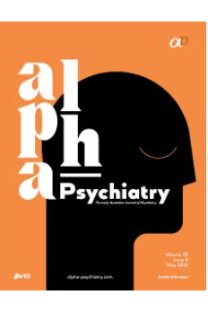DSM- 5 Depresyon Şiddet Ölçeği Çocuk Formu Türkçe sürümünün güvenilirliği ve geçerliliği
Validity and reliability of the Turkish version of DSM-5 Depression Severity Scale-Child Form
___
- 1. Brent DA, Birmaher B. Adolescent depression. N Engl J Med 2002; 347(9):667-671.
- 2. Fleming JE, Boyle MH, Offord DR. The outcome of adolescent depression in the Ontario Child Health Study Follow-up. J Am Acad Child Adolesc Psychiatry 1993; 32(1):28-33.
- 3. Lewinsohn PM, Rohde P, Seeley JR. Major depresif disorder in older adolescents: prevalence, risk factors and clinical implications. Clin Psychol Rev 1998; 18(7):765-794.
- 4. Costello EJ, Erkanli A, Angold A. Is there an epidemic of child or adolescent depression? J Child Psychol Psychiatry 2006; 47:1263-1271.
- 5. Copeland W, Shanahan L, Costello EJ, Angold A. Cumulative prevalence of psychiatric disor-ders by young adulthood: a prospective cohort analysis from the Great Smoky Mountains Study. J Am Acad Child Adolesc Psychiatry 2011; 50:252-261.
- 6. Demir T, Karaçetin G, Demir DE, Uysal O. Epidemiology of depression in an urban population of Turkish children and adolescents. J Affect Disord 2011; 134:168-176.
- 7. Kessler RC, Avenevoli S, Ries Merikangas K. Mood disorders in children and adolescents: an epidemiologic perspective. Biol Psychiatry 2001; 49:1002-1014.
- 8. Leaf PJ, Alegria M, Cohen P, Goodman SH, Horwitz SM, Hoven CM et al. Mental health service use in the community and schools: results from the fourcommunity MECA study--methods for the epidemiology of child and adolescent mental disorders study. J Am Acad Child Adolesc Psychiatry 1996; 35:889-897.
- 9. Birmaher B, Brent D, AACAP Work Group on Quality Issues, Bernet W, Bukstein O, Walter H, et al. Practice parameter for the assessment and treatment of children and adolescents with depressive disorders. J Am Acad Child Adolesc Psychiatry 2007; 46(11):1503-1526.
- 10. Öy B. Çocuklar için Depresyon Ölçeği: Geçerlik ve güvenirlik çalışması. Türk Psikiyatri Derg 1991; 1(34):132-136.
- 11. Tatar A, Kayıran SM, Saltukoğlu G, Özkut EŞZ, Emeksiz M. Analysis of the Center for Epidemiologic Studies Depression Scale (CES-D) in children and adolescents from the perspective of the item response theory. Bulletin of Clinical Psychopharmacology 2013; 23(3):242-253.
- 12. Meyers K, Winters NC. Ten-year review of Rating Scales. II: Scales for internalizing disorders. J Am Acad Child Adolesc Psychiatry 2002; 41(6):634- 659.
- 13. Pavuluri M, Birmaher BA. Practical Guide to Using Ratings of Depression and Anxiety in Child Psychiatric Practice. Curr Psychiatry Rep 2004; 6:108-116.
- 14. Amerikan Psikiyatri Birliği. Ruhsal Bozuklukların Tanısal ve Sayımsal Elkitabı, beşinci baskı (DSM5). Washington DC: Amerikan Psikiyatri Birliği, 2013, E Köroğlu (Çev. Ed.), Ankara: HYB, 2013.
- 15.http://www.psychiatry.org/practice/dsm/dsm5/onlin e-assessment-measure
- 16. Köroğlu E, Aydemir Ö, Türkçapar H. Psikiyatride Araştırma Tasarımı, Yönetimi ve Denetimi. Ankara: HYB, 2012.
- ISSN: 1302-6631
- Yayın Aralığı: 6
- Başlangıç: 2000
- Yayıncı: -
Olanzapine bağlı geç başlangıçlı okülojirik kriz
İbrahim GÜNDOĞMUŞ, Mustafa İSPİR, Osman BAKKAL, Ayhan ALGÜL
İzmit'te yaşayan ergenlerde kendine zarar verme davranışı ve aile özellikleri ile ilişkisi
İrem Damla ÇİMEN, Ayşen COŞKUN, Serhat NASIROĞLU, Nilay ETİLER
KKTC'de ilkokul öğrencileri arasında psikoaktif maddelerin kullanım yaygınlıkları ve risk etkenleri
Ebru T. ÇAKICI, Buse KESKİNDAĞ, Meryem KARAAZİZ, Mehmet Çağlar ÇAKICI
Perinatal Yas Ölçeği (33 maddeli Kısa Sürüm): Türkçe geçerlilik ve güvenili rlik çalışması
Miray Özgür KÖNEŞ, Meltem MECDİ KAYDIRAK, ERGÜL ASLAN, HATİCE YILDIZ
Bir ergende psikotik belirtilere neden olan oxybutynin kötüye kullanımı
Mehmet Akif CANSIZ, Yusuf ÖZTÜRK, Ali Evren TUFAN, Derya ARSLAN
Olanzapine-induced delayed-onset oculogyric crisis
Mustafa İSPİR, Osman BAKKAL, İBRAHİM GÜNDOĞMUŞ, Ayhan ALGÜL
Bipolar I bozukluğu için potansiyel bir biyomarker: Serum arjinin vasopressin düzeyleri
AKİF ASDEMİR, MUSTAFA TAYFUN TURAN, Cengiz UYSAL, ESER KILIÇ
Oxybutynin abuse in an adolescent leading to psychotic symptoms
Derya ARSLAN, MEHMET AKİF CANSIZ, Ali Evren TUFAN, YUSUF ÖZTÜRK
Erken dönem uyumsuz şemaların ergenlik dönemi depresif bozuklukla ilişkisi
Sebla GOKCE, Arzu ÖNAL SÖNMEZ, Canan YUSUFOĞLU, YASEMİN YULAF, İBRAHİM ADAK
